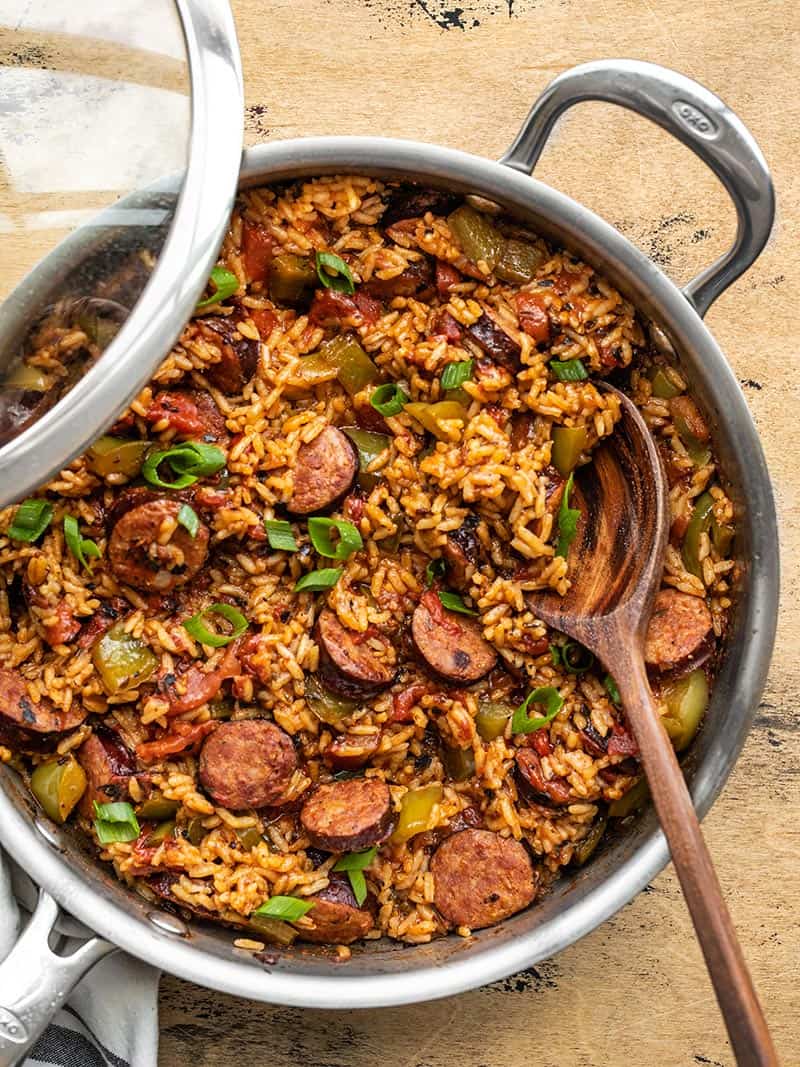To cook deer sausage on a stove, simply pan-fry it over medium heat for about 12-15 minutes, turning frequently for even cooking. Ensure the internal temperature reaches 160°F for safety.
Cooking deer sausage on the stove is an easy and flavorful way to enjoy this gamey meat. Deer meat, known for its lean quality, makes for delicious sausages that can add a wild twist to your regular meals. Whether you’re an experienced chef or a novice in the kitchen, preparing deer sausage is straightforward and requires minimal ingredients and equipment.
By following the proper steps, including monitoring the heat and using a bit of oil to prevent sticking, you can achieve perfectly cooked sausage that’s packed with flavor. This type of meat not only offers a unique taste but also brings a sense of adventure to your dining experience. Remember to always check the internal temperature to ensure it is fully cooked for a safe and delectable meal.
Introduction To Cooking Deer Sausage
Deer sausage brings a unique twist to traditional flavors. Cooking deer sausage on the stove is a simple process that yields delicious results. Whether you’re new to game meat or a seasoned chef, this guide ensures a perfectly cooked sausage every time.
A Culinary Adventure With Game Meat
Embrace the taste of the wild! Deer sausage is a staple for those who appreciate rich, gamey flavors. It’s a versatile ingredient that can elevate any meal. Follow these steps for a memorable culinary experience:
- Start with high-quality deer sausage.
- Ensure even heating on the stove.
- Use a heavy skillet for consistent cooking.
- Monitor the temperature closely.
Health Benefits Of Deer Sausage
Deer sausage not only tastes great, but it’s also packed with health benefits. Rich in proteins and low in fat, it’s an excellent choice for those watching their diet. Here’s a quick look at the benefits:
| Benefit | Description |
|---|---|
| Lean Protein | Helps build and repair tissues. |
| Low Fat | Reduces intake of saturated fats. |
| Rich in Iron | Boosts energy and metabolism. |
| Vitamins | Contains B vitamins, vital for health. |

Credit: www.budgetbytes.com
Selecting Your Deer Sausage
Before you cook deer sausage on the stove, choosing the right sausage is key. For a delicious meal, start with great ingredients.
Fresh Vs. Smoked Varieties
Fresh deer sausage is raw and must be cooked thoroughly. Smoked sausage has a rich aroma. It is pre-cooked and ready to heat.
Identifying Quality Deer Sausage
Look for firm texture and consistent color. Smell for a pleasant gamey aroma. Avoid any sausage with strange odors.
Remember, high-quality sausage ensures a tasty, safe meal. Select with care and look forward to a flavorful experience on your plate.
Preparation Before Cooking
Starting the journey to a delicious deer sausage dish begins well before it hits the stove. Proper preparation ensures that your meal is not only delectable but also safe to eat. Here, grasp the steps required to perfectly prep your deer sausage for a memorable culinary experience.
Thawing Frozen Sausages Safely
Thawing deer sausage correctly is paramount for both safety and flavor. Utilize these methods for best results:
- Refrigerator Thawing: Transfer sausages from the freezer to the fridge and let rest for 24 hours.
- Cold Water Thawing: Keep sausages in their packaging and submerge in cold water, changing the water every 30 minutes.
- Microwave Thawing: Use the defrost setting if you’re pressed for time, but cook immediately after.
Essential Spices And Herbs For Marinating
Enhancing the sausage’s flavor is a breeze with the right mix of spices and herbs. Here’s a must-have list:
| Spices | Herbs |
|---|---|
| Pepper | Rosemary |
| Garlic Powder | Thyme |
| Onion Powder | Sage |
| Paprika | Oregano |
| Cayenne | Parsley |
Combine these aromatics with a base of oil or a wet ingredient like apple cider vinegar for a marinade that infuses your deer sausages with robust flavors. Let them soak in these rich flavors for at least an hour or, even better, overnight in the fridge.

Credit: www.wikihow.com
Tools And Utensils Needed
Before you dive into cooking juicy deer sausages, make sure you have the right equipment. Gather tools and utensils to turn raw sausages into delicious, golden-brown delights. With the correct set up, you’ll ensure an evenly cooked sausage that’s bursting with flavor. Let’s look at the essentials.
Best Skillets For Sausage Cooking
Selecting a skillet is key for cooking sausages. The right one distributes heat evenly and holds the temperature well. A cast-iron skillet is a popular choice. It’s durable and retains heat, cooking your sausages perfectly. Non-stick pans can also work, but be gentle to avoid scratching the surface. Remember, a good skillet makes a difference!
- Cast-iron skillet – Ideal for searing and even cooking.
- Non-stick skillet – Easy to clean and requires less oil.
- Stainless steel skillet – Great for browning sausages.
Additional Cooking Accessories
Some accessories can enhance the cooking experience. Use a meat thermometer to check for safe internal temperatures. Tongs are perfect for turning the sausages without piercing them. If you like to add flavor, a marinade brush can apply sauces or oils evenly.
- Meat thermometer – Ensures sausages are cooked thoroughly.
- Tongs – For flipping sausages without puncturing them.
- Marinade brush – Spreads sauces and oils uniformly.
- Lid – Contains splatters and speeds up cooking.
- Paper towels – Absorb excess oil after cooking.
Stovetop Cooking Methods
Cooking deer sausage on a stovetop is a delightful way to prepare a hearty meal. This cooking method brings out the rich flavors of the meat. All you need is a pan and some simple ingredients. Let’s dive into how to cook deer sausage with two popular methods: pan-frying and simmering in liquid.
Pan-frying Deer Sausage Properly
To pan-fry deer sausage, first slice the sausages to desired thickness. Heat a skillet over medium heat. Add a small amount of oil. Once hot, place sausage slices in the skillet. Ensure they don’t overlap for even cooking. Cook for a few minutes on one side. Then flip the sausages to brown the other side. Once both sides are golden brown, remove sausages from the skillet. The internal temperature should reach 160°F for safety.
Simmering In Liquid For Added Juiciness
For extra juiciness, simmering deer sausages in liquid is ideal. Add sausages to a skillet. Cover them with broth, beer, or water. Bring liquid to a gentle simmer over medium heat. Cover the skillet with a lid. Let the sausages cook for about 12 minutes. Turn the sausages halfway through. This method keeps the sausages moist and infuses them with additional flavors. Once done, sausages should be plump. Confirm they reach the safe internal temperature of 160°F.
Maintaining Temperature Control
Cooking deer sausage on the stove requires careful attention to temperature. Consistent heat ensures your sausage cooks evenly without burning. Discover the art of perfect stove-top deer sausage with these tips.
Monitoring Heat Levels
A steady medium heat works best for cooking deer sausage. Use a thermometer to check the pan’s temperature regularly. Aim to keep it around 160°F to 170°F. This range helps cook the sausage thoroughly without overdoing it. Look out for the following signs to guarantee optimal cooking conditions:
- Sizzling sounds: Indicates it’s time to flip or rotate the sausage.
- Even coloring: Check for a uniform golden-brown casing.
Avoiding Common Mistakes
Common errors can lead to poorly cooked sausage. Dodge these pitfalls with ease:
- High heat: It can char the sausage. Keep the flame moderate.
- Frequent turning: Turn the sausage only a few times to cook evenly.
- Crowding the pan: Give each piece space for even heat distribution.
Keep a close eye on your stove setting, turning the dial as needed. A lower flame might be necessary if the pan starts smoking. Always adjust heat gradually for better control.
Serving Suggestions
After mastering the art of cooking deer sausage on the stove, the final touch involves serving it in a way that enhances its rich, gamey flavor. Think about the sides and presentation – they can elevate your dish from a simple meal to a memorable dining experience. Below, find suggestions to impress both the palate and the eyes.
Pairing With Side Dishes
Complement your deer sausage with sides that balance its robust taste. Here are top picks:
- Sautéed vegetables: They add freshness and color.
- Mashed potatoes: Their creaminess pairs well with sausage.
- Grilled corn: Its sweetness contrasts the meaty flavor.
- Rice or quinoa: These grains are perfect for soaking up juices.
- Spicy mustard: It offers a tangy kick.
Creative Presentation Ideas
Serve your deer sausage with a twist. Engage your guests’ sense of sight before they take a bite!
- Use colorful skewers for a fun, casual look.
- Arrange sausage slices in a spiral on a platter.
- Place a small bowl of dipping sauce in the center.
- Offer miniature sliders for a creative appetizer.
- Use fresh herbs for an aromatic garnish.
Storage And Leftover Ideas
Preparing deer sausage on the stove is only half the adventure. Knowing how to store your homemade sausages and creatively use any leftovers can transform your cooking experience. Let’s dive into the best ways to keep that delicious flavor fresh and exciting ideas for your remaining deer sausage.
Best Practices For Sausage Storage
It’s crucial to store deer sausages properly to maintain their taste and safety. Here are some top tips:
- Refrigerate promptly after cooking.
- Wrap tightly in plastic or foil to prevent air exposure.
- Keep refrigerated at or below 40°F.
- Freeze for long-term storage, using airtight containers or freezer bags.
- Label with the date and use within three months for best quality.
Reusing Leftovers In New Dishes
Leftover deer sausage sparks creativity in the kitchen. Transform them with these ideas:
- Slice and add to pasta dishes for extra flavor.
- Chop into scrambled eggs or omelets for a hearty breakfast.
- Mix into stews or soups to enrich the broth.
- Create a savory pie with sausages and vegetables.
- Make sausage fried rice for a quick, satisfying meal.
Enjoy these creative twists and never let a delicious sausage go to waste.
Safety Considerations
Deer sausage is a delicious game treat. Cooking it safely on your stove is important. You must keep two key safety aspects in mind. These are internal temperature and avoiding cross-contamination.
Internal Temperature Guidelines
Cooking deer sausage right ensures safety and taste. Use a meat thermometer. Measure the sausage’s internal temperature. It must reach 160°F (71°C) for safety. Check the temperature at the sausage’s center. This kills harmful bacteria. Rest the sausage after cooking. This lets the heat spread evenly.
Cross-contamination Concerns
Prevent cross-contamination to keep food safe. Start with clean surfaces and tools. Separate raw deer sausage from other foods. Use different cutting boards. Clean everything touched by raw meat. Hands, utensils, and counters need washing with soap and hot water. Be thorough to guarantee a safe cooking environment.

Credit: www.wikihow.com
Frequently Asked Questions On How To Cook Deer Sausage On Stove?
What’s The Best Pan For Cooking Deer Sausage?
A quality non-stick skillet or cast iron pan is ideal for cooking deer sausage. These pans provide even heat and prevent sticking, ensuring your sausage cooks thoroughly without burning or tearing.
How Long Should Deer Sausage Cook On The Stove?
Deer sausage should be cooked for about 10 to 12 minutes on the stove over medium heat. Turn them occasionally to ensure even cooking and a crisp, browned exterior without overcooking.
Can I Cook Deer Sausage In Oil Or Butter?
Yes, you can cook deer sausage in a small amount of oil or butter. This helps to brown the sausage nicely and adds extra flavor. Use a light oil with a high smoke point or a small knob of butter for the best results.
What Internal Temperature Ensures Deer Sausage Is Done?
Deer sausage is considered done when it reaches an internal temperature of 160°F (71°C). Always use a meat thermometer to check for doneness and ensure food safety.
Conclusion
Cooking deer sausage on the stove is simpler than you might think. Just follow the steps outlined for tasty results. Perfecting the savory flavors at home brings culinary satisfaction. Give it a try, and prepare for a delicious, hearty meal that’s sure to impress.
Enjoy your homemade creation!

Hi, this is Cynthia A. Rose. Welcome to my Grinder related blog. Usually, I am busy with my kitchen and cooking all day. My main desire is to create a new recipe every day. But I have to use new tools every day to create new recipes. In this blog, I will share you how to use kitchen tools properly. I will not just share cooking related equipment, I will try to review all kinds of grinders like angle grinder among you. I hope my 12 years of experience will come in handy. Thanks!





